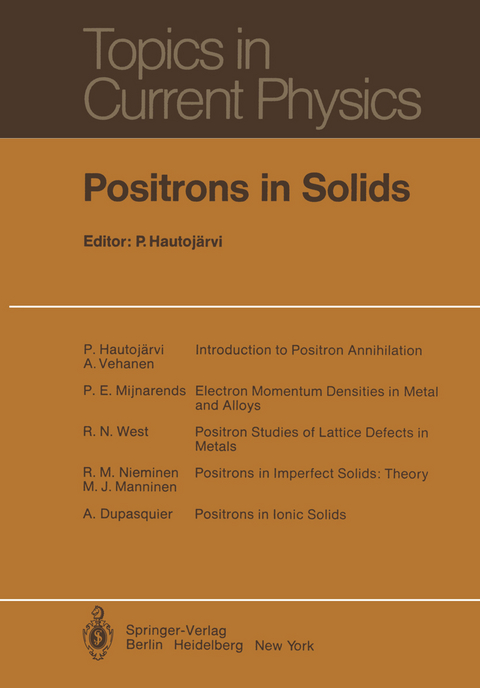
Positrons in Solids
Springer Berlin (Verlag)
978-3-642-81318-4 (ISBN)
In condensed matter initially fast positrons annihilate after having reached equi librium with the surroundings. The interaction of positrons with matter is governed by the laws of ordinary quantum mechanics. Field theory and antiparticle properties enter only in the annihilation process leading to the emergence of energetic photons. The monitoring of annihilation radiation by nuclear spectroscopic methods provides valuable information on the electron-positron system which can directly be related to the electronic structure of the medium. Since the positron is a positive electron its behavior in matter is especially interesting to solid-state and atomic physi cists. The small mass quarantees that the positron is really a quantum mechanical particle and completely different from any other particles and atoms. Positron physics started about 25 years ago but discoveries of new features in its interac tion with matter have maintained continuous interest and increasing activity in the field. Nowadays it is becoming part of the "stock-in-trade" of experimental physics.
1. Introduction to Positron Annihilation.- 1.1 Positron Method.- 1.2 Annihilation of Free Positrons.- 1.3 Experimental Techniques.- 1.4 Positroniurn Formation and Annihilation.- 1.5 Topics of Positron Studies.- 1.6 Summary.- References.- 2. Electron Momentum Densities in Metals and Alloys.- 2.1 Theory.- 2.2 Wave Functions.- 2.3 Experimental Techniques.- 2.4 Momentum Density Work in Metals.- 2.5 Disordered Alloys and Ordered Metallic Compounds.- 2.6 Conclusion.- References.- 3. Positron Studies of Lattice Defects in Metals.- 3.1 Annihilation Parameters for Defect Studies.- 3.2 Monovacancies in Equilibrium.- 3.3 Nonequilibrium Studies.- 3.4 Defect Studies in Alloys.- 3.5 Liquid and Amorphous Metals.- References.- 4. Positrons in Imperfect Solids: Theory.- 4.1 Positron Distribution, Mobility, and Trapping.- 4.2 Defects in Metals.- 4.3 Nonmetals.- 4.4 Conclusions.- References.- 5. Positrons in Ionic Solids..- 5.1 Experimental Methods.- 5.2 Annihilation Characteristics in Alkali Halides.- 5.3 Positron States in Alkali Halides.- 5.4 Annihilation in Other Ionic Compounds.- References.- Additional References with Titles.
| Erscheint lt. Verlag | 14.12.2011 |
|---|---|
| Reihe/Serie | Topics in Current Physics |
| Co-Autor | A. Dupasquier |
| Zusatzinfo | XIV, 258 p. |
| Verlagsort | Berlin |
| Sprache | englisch |
| Maße | 170 x 244 mm |
| Gewicht | 481 g |
| Themenwelt | Naturwissenschaften ► Physik / Astronomie ► Allgemeines / Lexika |
| Schlagworte | atoms • density • diffraction • Diffusion • electron • Elektron-Positron-Vernichtung • Enthalpy • Festkörper • Field Theory • Kinetics • Mechanics • metals • Photon • Physics • quantum mechanics • Radiation • solids • Wave |
| ISBN-10 | 3-642-81318-6 / 3642813186 |
| ISBN-13 | 978-3-642-81318-4 / 9783642813184 |
| Zustand | Neuware |
| Haben Sie eine Frage zum Produkt? |
aus dem Bereich


